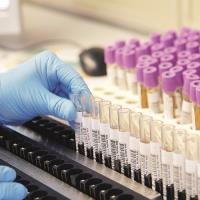 Add My Company
Add My Company
Sign In

Identifiable, trackable and traceable: blood sample labels
When it comes to labelling and packaging in any industry, it’s vital that the correct information is displayed. Incorrect data leads to time being wasted and money being lost – two valuable commodities. However, in the healthcare industry, incorrect data can lead to something far graver being lost, something which can’t be commodified: human life.
When it comes to labelling and packaging in any industry, it’s vital that the correct information is displayed. Incorrect data leads to time being wasted and money being lost – two valuable commodities. However, in the healthcare industry, incorrect data can lead to something far graver being lost, something which can’t be commodified: human life.
Collecting blood samples is an unavoidable reality of patient care within hospitals and other primary care settings. Blood tests help diagnose serious diseases, they indicate how well organs are working, and they reveal how a patient is responding to certain treatments. Therefore, it’s imperative that all blood sample labels are recorded accurately and identifiable to ensure patient safety.
The knock-on effect of inaccuracy
In short, if a blood sample is labelled incorrectly another blood test will have to be taken. Now, this may not seem like a huge deal, but in such a critical setting as a hospital, wasted seconds and minutes can make all the difference.
In order to protect patient safety, most laboratories will not accept blood samples or transfusion tests that are not correctly labelled or have been altered in any way. That’s why healthcare professionals will confirm your identity (usually your name and date of birth) before collecting a sample, and reaffirm your identity before delivering the sample to a laboratory.
If a specimen cannot be accurately identified, it can lead to delayed or wrong diagnosis, incorrect or missed treatments, blood transfusion errors, and more. Ultimately, it means that additional testing will be required, which results in further delays.
How to reduce labelling errors
The following information should be displayed on all blood samples and cross referenced against an ID band for all inpatients:
Surname
Forename
Date of birth
Unique identity number such as NHS number
For organisations operating within the healthcare sector, three steps should be taken to help reduce specimen labelling errors:
Use more than one patient identifier: to ensure a patient’s blood sample can be accurately identified and there is no confusion, organisations should use more than one patient identifier (patient’s full name, date of birth, NHS number, etc).
Carry out regular labelling audits: handwritten labels increase the chances of blood samples being misinterpreted, so you should carry out regular audits to make sure all staff are following collect labelling procedures.
Implement a barcode ID system: handwritten labels can result in data being recorded incorrectly. A barcode system negates this possibility with an instantly scannable and recognisable barcode that identifies the patient accurately and quickly.
We specialise in labelling reliability
If there was ever an industry where identification, tracking, traceability and process control were vital, the healthcare sector is it. After working in partnership with a diverse range of providers and suppliers across the sector for a number of years, we at Dura-ID recognise the importance of getting things right at the first time of askin
For more information on Identifiable, trackable and traceable: blood sample labels talk to Dura-ID Solutions Limited
Enquire Now
List your company on FindTheNeedle.

